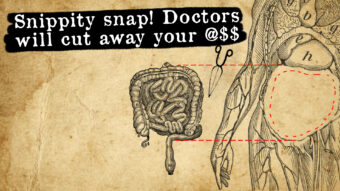 On the morning of March 23, 1976, the peace of Tokyo’s Satagawa neighbourhood was shattered as a small aircraft came screaming out of the sky and slammed into the side of a large two-story house. The plane burst into a giant fireball on impact, setting the house ablaze and injuring two of its occupants, though miraculously no-one but the pilot was killed. But as firefighters and police arrived on the scene, it soon became clear that this was not some tragic accident but rather a deliberate attempt at assassination – kamikaze style. The intended victim? Japan’s most notorious crime boss. The assassin? A troubled porn actor obsessed with the bushido samurai code. And the motive? One of the greatest political scandals in Japanese history.
On the morning of March 23, 1976, the peace of Tokyo’s Satagawa neighbourhood was shattered as a small aircraft came screaming out of the sky and slammed into the side of a large two-story house. The plane burst into a giant fireball on impact, setting the house ablaze and injuring two of its occupants, though miraculously no-one but the pilot was killed. But as firefighters and police arrived on the scene, it soon became clear that this was not some tragic accident but rather a deliberate attempt at assassination – kamikaze style. The intended victim? Japan’s most notorious crime boss. The assassin? A troubled porn actor obsessed with the bushido samurai code. And the motive? One of the greatest political scandals in Japanese history.
To understand the events that led to the March 23 attack, it is important to understand the political and social climate of Japan in the 1970s. For many Japanese people, Japan’s unconditional surrender to the United States on September 2, 1945 was a national disgrace. In the immediate post-war years, Japan effectively became an Allied puppet state, with American general Douglas MacArthur as the new Emperor in all but name. During this period, the Allies disarmed the Japanese military forces, banned the nationalist religion of State Shinto, arrested and tried Japanese leaders for war crimes, extracted over $1 billion in reparations for countries ravaged by Japan’s war of conquest, and forcibly replaced Japan’s military government with a western-style parliamentary democracy. Eventually, however, the Allies realized Japan’s value as a bulwark against communism in Asia and, in April 1952, ended their occupation and restored the nation’s independence. But this was independence with a catch, for the 1951 U.S.-Japan Security Treaty granted the United States the exclusive right to station more than a quarter of a million troops on Japanese soil, while the U.S. government and American corporations continued to exert massive influence over Japanese politics and industry. These measures proved deeply unpopular with the Japanese people, leading to a string of violent protests throughout the 1950s.
Amid this ongoing national humiliation emerged a powerful Right-Wing Nationalist movement, which rejected both capitalism and communism and yearned to restore Japan’s lost honour and return the nation to its militaristic glory days of the 1930s and 40s. At their peak in the 1970s, the Nationalists numbered in the hundreds of thousands, divided among dozens of militia groups scattered across the country. Among these was the Tatenokai, or “Shield Society,” led by celebrated poet, playwright, and actor Yukio Mishima. On November 25, 1970, Mishima and four of his followers infiltrated the central Tokyo headquarters of the Japanese Self-Defense Forces, took the commandant hostage, and barricaded themselves inside the building. Then, wearing a traditional hachimachi headband bearing the rising sun emblem and the motto “To be reborn seven times to serve the country,” Mishima appeared on a balcony and delivered a passionate speech to the soldiers gathered below, calling on them up against the government and restore control of the military – and all of Japan – to the Emperor. Unfortunately, Mishima’s speech inspired only jeers and heckling, and when it became clear that no uprising was forthcoming, the poet-turned-revolutionary committed seppuku or ritual suicide, disemboweling himself with a knife while a follower decapitated him with a sword.
While Mishima’s attempted coup d’état was a dismal failure, his example inspired a whole generation of young romantic nationalists, including our soon-to-be kamikaze assassin, one Mitsuyasu Maeno. Little is known about Maeno’s early life. Born in Tokyo in 1946 or 1947, Maeno took to acting at a young age, joining various theatrical groups as a teenager and appearing in his first film in 1959. He later took acting classes at the University of California in 1967 before returning to Japan to start his acting career. Unfortunately, Maeno found film roles hard to come by, and was forced to appear in low-budget exploitation films like 1970’s Stray Cat Rock: Wild Jumbo and a popular style of Japanese soft-core pornography known as pink film. In the 1970s, pink films made up nearly 2/3 of all films made in Japan, with the most popular being the “Roman Porno” series made by Studio Nikkatsu. Maeno appeared in 20 of Nikkatsu’s Roman Pornos, the highest-profile of which being 1975’s Tokyo Emmanuelle, in which Maenos’s character makes love to actress Kumi Taguchi while flying a plane.
Maeno’s personal life was equally troubled. He was married twice, first to Japanese actress Noriko Kurosawa and later to an American woman, but both marriages quickly ended in divorce. Distraught, in February 1976 Maeno attempted suicide by overdosing on suicide pills. He was found lying in the snow outside the hot springs resort town of Yuzawa and rushed to hospital, where he soon recovered. Sometime after Yukio Mishima’s attempted coup in 1970, Maeno became fanatically devoted to the Nationalist cause, and yearned for an opportunity to prove his courage and redeem his country’s lost honour. That opportunity would soon come in the form of a scandal that rocked Japanese society to its very core.
In February 1976, a U.S. Senate sub-committee led by Idaho Senator Frank Church revealed that the California-based Lockheed Aircraft Corporation had paid out more than $22 million in illegal bribes to foreign governments as enticement to purchase their products. Recipients of these bribes included Japan, the Netherlands, Saudi Arabia, Italy, and West Germany, whose purchase of 916 F-104 Starfighters was trumpeted was “The Sale of the Century.” According to testimony by Lockheed executives, despite securing $250 million in government loans, by the early 1970s the company was on the edge of bankruptcy. Delays in the release of its new L-1011 [“Ell-Ten-Eleven”] Tristar airliner had resulted in disappointing sales, with most airlines opting instead for the competing Douglas DC-10. Sales of other aircraft were equally disappointing. The F-104 Starfighter, introduced in 1958 as a high-speed, high altitude interceptor for shooting down Soviet nuclear bombers, was short-lived in U.S. Air Force service, being replaced after only 11 years by more versatile aircraft. In desperation, Lockheed marketed the Starfighter as a low-level ground-attack aircraft, exporting the type to 14 friendly nations including Canada, Germany, Denmark, Turkey, and Taiwan. However, the F-104 proved ill-suited to this new role, resulting in dozens of pilots dying in training accidents and the aircraft acquiring the nickname “The Widowmaker.” Indeed, the Japanese Defense Forces had already selected the Grumman F11 Super Tiger as its primary fighter aircraft before Lockheed bribes convinced them to switch to the F-104. In addition to the Starfighter, Lockheed also bribed Japanese airline All Nippon Airways to adopt the L1011 over the DC-10 and the Italian Air Force to purchase C-130 Hercules transports.
News of the Lockheed Bribery Scandal caused many key figures to resign in disgrace, including Italian President Giovanni Leone and several top Lockheed executives. In the Netherlands, Prince Bernhard, who had received $1.1 million to ensure the F-104 won out over France’s Dassault Mirage 5, was forced to step down from public positions and forbidden from wearing his military uniforms. But nowhere was the impact of the scandal more keenly felt than in Japan, for it laid bare what had long been an open secret in Japanese politics. While the United States had attempted to impose upon Japan a western-style parliamentary democracy, this foreign import failed to stick, and Japanese politics quickly devolved into what New York Times reporter Jerome Cohen described in 1976 as:
“…[a] loose oligarchy of conservative politicians that goes by the name of the Liberal Democratic Party. Power derives from factions, and factions coalesce around leaders picked less for ideological considerations than for political talent —particularly ability to raise money. The money is used by the leader and his cohorts to win elections and solidify ties with constituents…. Each faction strives to place its members in ministerial and other high posts. Its ultimate goal is to elect its leader to the party presidency, thus assuring his selection as Prime Minister, assuming the Liberal Democrats remain in the majority in Parliament. Faction leaders are constantly contending, negotiating and conspiring in teahouses, geisha restaurants and hot‐spring resorts, and every Cabinet reshuffle reflects the latest temporary coalition of forces. Occasionally one faction leader will give a large sum of money to other leaders to win favour with them and their followers.”
Indeed, with the exception of five years from 1993 to 1994 and from 2009 to 2012, the Liberal Democratic Party has ruled Japan almost continuously since its founding in 1955. In Japanese politics of the 1970s, bribery was a fact of life, with Cohen going on to state:
“Japanese law makes it a crime for any public official…Between a legal political contribution and an illegal bribe lies a murky area no legislation has yet succeeded in regulating. In a society where giftgiving is a traditional, widely practiced and subtle art, the law is applied only against those who give and receive financial benefits plainly outside the bounds of customary gift‐giving. Bribe givers frequently resort to ingenious subterfuge. “Stuffing cash in biscuit boxes or whisky cartons, preferably wrapped in the paper of major department stores, has become an accepted way of making an inconspicuous bribe,” notes The Far Eastern Economic Review. “Cartons of Old Parr whisky are said to be especially popular, as 10,000‐yen notes fit inside perfectly.”
In the case of the Lockheed Scandal, this ingrained culture of bribery had an even shadier dimension, for one of the key players in the affair was one Yoshio Kodama, a high-ranking figure in the Yakuza, or Japanese mafia. Born in Nihonmatsu in 1911, Kodama joined the Yakuza at age 12, serving as an enforcer and beating up trade unionists. In the 1920s and 30s, he became involved with various right-wing ultranationalist groups, which sought to fulfill what they saw as Japan’s manifest destiny to dominate all of Asia. To this end, Kodama organized the murder of several Japanese politicians advocating for peaceful relations between Japan, Korea, and China, and planned the assassination of Prime Minister Saito Makoto. The latter plot was unsuccessful, resulting in Kodama being arrested and imprisoned. Following the outbreak of the Second Sino-Japanese War in 1937, Kodama was released at the behest of Imperial Japanese Army General Kenji Doihara and sent to Japanese-occupied Manchuria. There he served as a spy and fixer for Chinese collaborationist forces, helping to root out and suppress resistance to the Japanese occupation. During this period, Kodama also engaged in the violent and large-scale plunder of the Chinese countryside, confiscating whatever valuables he could get his hands on and selling them for a large profit back in Japan. Thanks to these activities, by 1945 Kodama had become one of the wealthiest men in Japan, with assets worth some $175 million USD. After the war, Kodama was arrested and investigated by the United States as a suspected Class-A war criminal, but was soon released and recruited by U.S. Military Intelligence to fight the rise of socialism and communism in Japan. At the same time, Kodama returned to his underworld roots, helping to unite several Yakuza clans and amassing an even greater fortune through opium smuggling. By the early 1950s he had become one of Japan’s most successful and infamous kuromaku or behind-the-scenes power brokers, helping to found the Liberal Democratic Party and launching the careers of several Japanese politicians including Nobusuke Kishi and Kakuei Tanaka, the Prime Minister at the time of the Lockheed Scandals.
In 1969, Kodama was approached by Lockheed to be the middleman for its bribery payments. Over the next 5 years, Kodama received and funnelled more than $12 million in Lockheed bribes to various officials including Prime Minister Tanaka, Finance Minister Eisaku Sato, Japanese Self-Defense Forces Chief of Staff Minoru Genda, top executives of the Marubeni Corporation and All Nippon Airways, and, of course, himself. When the scandal broke in 1976, many of Kodama’s fellow ultranationalists were aghast, seeing his collaboration with a company whose aircraft had devastated Japan during the War as a betrayal of everything the claimed to stand for. Many even called for Kodama to commit seppuku to atone for his disgrace. Particularly incensed was Mitsuyasu Maeno, who upon learning of the scandal declared Kodama to be without honour and vowed to kill him in the most heroic fashion possible: by crashing an aircraft into his house in the style of the wartime kamikaze suicide pilots.
At the time, Maeno held a private pilot’s license and was registered at the Taiyo Flying Club on the outskirts of Tokyo. In early March 1976, Maeno rehearsed for his attack by making several flights over Kodama’s home in Tokyo’s Satagawa Ward. While Kodama had been indicted for his role in the Lockheed Scandal on March 13, the 65-year-old Yakuza boss had recently suffered a stroke and was declared too ill to appear in court. Maeno was therefore confident that Kodama would be home when he finally launched his attack.
On the morning of March 23, Maeno rented a kamikaze pilot costume complete with fur-trimmed flight suit and hachimachi headband and arrived at the Taiyo airport with two friends. Maeno told the airport that he was appearing in a movie about the kamikaze and wanted to shoot a publicity reel to help promote the film. After posing for a photograph, at 9AM Maeno and his friends took off in two Piper Cherokee aircraft and headed out over Tokyo. They flew around aimlessly for around an hour until Maeno declared over the radio that he had business in Satagawa – the secret signal for the attack to begin. As Maeno banked towards Kodama’s neighbourhood, his friends in the other plane followed, filming the attack with a home movie camera. Maeno circled the house twice before switching on his radio and announcing:
“JA3551 – Sorry I haven’t replied for a long time. Tenno Heika Banzai! [Long live the emperor!]”
Then, at 9:50 AM, Mitsuyasu Maeno dove his aircraft and slammed it into the side of Kodama’s house, dying instantly in a blaze of glory. One local resident later described the scene:
“There wasn’t a big sound of an explosion but the smell of fuel filled the air. Someone told me a small plane had crashed into Kodama’s house and I rushed to the roof to look. The property was surrounded by high, thick walls that muffled the sound and made it hard to see what was going on. Policemen soon swarmed the site. None of us understood what it was all about.”
Miraculously, while two servants were injured by the fireball, nobody but Maeno was killed. Kodama, the intended target, was resting in another part of the house and was unharmed. As Kodama’s servants carried him to safety in a blanket, his Yakuza bodyguards rushed into the house to fight the flames. The fire department soon arrived, and within 20 minutes the blaze was brought under control. Word of the attack spread quickly, drawing a group of around 70 ultranationalists who surrounded Kodama’s property and clashed with police attempting to enter the house.
Reactions to Maeno’s brazen assassination attempt were mixed. While his fellow ultranationalists praised him for embodying the spirit of the samurai, others were less impressed, with an editorial in the newspaper Mainichi Shimbun asking:
“Is it imaginable that a young German, not a wartime officer, would commit suicide in a Nazi uniform, shouting ‘Heil Hitler!’? Coming more than 30 years after the end of World War II, Maeno’s kamikaze flight revived the ghost the Japanese wanted to forget.”
Keiichi Ito, the director-general for training of the Japan Self-Defense Forces and a former kamikaze pilot, dismissed Maeno’s supposed heroism, declaring:
“Maeno was performing an egotistical, grandstand play to win publicity, not unlike Mishima’s suicide. Both were showing off to the world.”
However, in an amusing case of “game recognizing game,” Ito went on to praise Maeno’s technique in carrying out the attack, calling his piloting:
“…very skillful. I give him the highest marks on that score
But in the end, Japan’s last kamikaze attack would have no impact on the scandal which inspired it. On July 27, 1976, Prime Minister Tanaka was arrested and formally charged with taking $1.6 million in bribe money. His trial ended in conviction on October 12, 1983, with Tanaka being sentenced to 4 years in jail and a ¥500 million or $4.3 million USD fine. Tanaka immediately launched an appeal, which lingered in the courts for years. During this time, Tanaka managed to retain his grip on power, winning the December 1983 election by an unprecedented margin. However, on February 7, 1985, Tanaka suffered a stroke and spent the next decade in and out of hospitals as his political power gradually waned, He died of pneumonia on December 16, 1993, having not served not one day of his mandated jail sentence.
Meanwhile, across the Pacific, Lockheed chairman Daniel Haughton and president Carl Kotchtian were forced to resign their positions, while the scandal prompted the drafting of the 1977 Foreign Corrupt Practices Act, which prohibited American corporations making payments to foreign governments to advance their business interests. Lockheed was also forced to cancel all its contracts with Japan and several other nations, leaving the company in an even worse financial position than before. Lockheed was only saved from bankruptcy or hostile takeover by a 1994 merger with Martin-Marietta Corporation, creating the company now known as Lockheed-Martin.
But what of the central figure in our story, Yoshio Kodama? Kodama’s trial officially began in June 1977, but had to be postponed on account of the Yakuza boss’ poor health. But before the trial could be concluded, Kodama suffered another stroke and died on January 17, 1984, escaping justice just like his client Kakuei Tanaka. But one has to wonder: had Mitsuyasu Maeno’s attack been successful, would an old ultranationalist like Kodama have seen it as the more honourable way to go? We shall never know. All we do know is that this story of corruption, scandal, attempted coups, and a kamikaze porn star is one of the wildest we have ever covered on this channel.
If you liked this article, you might also enjoy our new popular podcast, The BrainFood Show (iTunes, Spotify, Google Play Music, Feed), as well as:
Expand for References
Halloran, Richard, A Japanese Dives Plane Into House of Lockheed Agent, The New York Times, March 23, 1976, https://ift.tt/iYjcR7H
Nambi, Karthick, When a Porn Star Crashed His Plane Into a Crime Boss’s Home in Japan, Medium, December 21, 2021,
Hornyak, Tim, Japan Rewind: 40 Years Since the Porn Star’s Kamikaze Attack in Tokyo, Tokyo Reporter, June 10, 2016, https://www.tokyoreporter.com/japan-news/national/japan-rewind-40-years-since-the-porn-stars-kamikaze-attack-in-tokyo/
Cohen, Jerome, Japan’s Watergate: Made in U.S.A, The New York Times, November 21, 1976, https://www.nytimes.com/1976/11/21/archives/japans-watergate-made-in-usa-japan.html?_r=0
Jones, William & Berry, John, Lockheed Paid $38 Million in Bribes Abroad, The Washington Post, May 27, 1977, https://www.washingtonpost.com/archive/business/1977/05/27/lockheed-paid-38-million-in-bribes-abroad/800c355c-ddc2-4145-b430-0ae24afd6648/
Saxon, Wolfgang, Yoshio Kodama; Was Rightist, The New York Times, January 18, 1984, https://www.nytimes.com/1984/01/18/obituaries/yoshio-kodama-was-rightist.html
Weiner, Tim, CIA Spent Millions to Support Japanese Right in 50’s and 60’s, The New York Times, October 9, 1994, https://ift.tt/3JM8sz4






